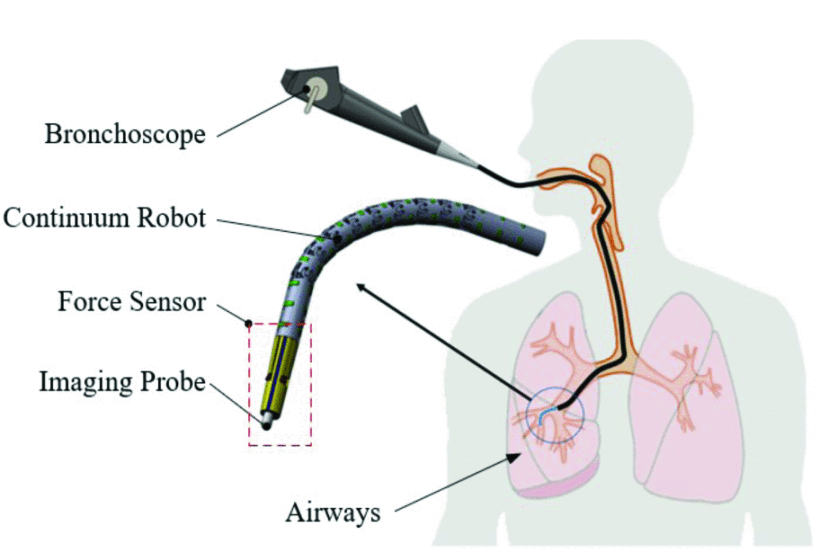Congratulations to Prof. Guang-Zhong Yang, Prof. Weidong Chen, Prof. Le Xie, Prof. Hesheng Wang and their teams for having their papers accepted for presentation at "ICRA 2020".
Cheng Zhao, Mali Shen, Li Sun, Guang-Zhong Yang. “Generative localisation with Uncertainty Estimation through Video-CT data for Bronchoscopic Biopsy.” International Conference on Robotics and Automation (ICRA), 2020.
Robot-assisted endobronchial intervention requires accurate localisation based on both intra- and preoperative data. Most existing methods achieve this by registering 2D videos with 3D CT models according to a defined similarity metric with local features. Instead, we formulate the bronchoscopic localisation as a learning-based global localisation using deep neural networks. The proposed network consists of two generative architectures and one auxiliary learning component. The cycle generative architecture bridges the domain variance between the real bronchoscopic videos and virtual views derived from pre-operative CT data so that the proposed approach can be trained through a large number of generated virtual images but deployed through real images. The auxiliary learning architecture leverages complementary relative pose regression to constrain the search space, ensuring consistent global pose predictions. Most importantly, the uncertainty of each global pose is obtained through variational inference by sampling within the learned underlying probability distribution. Detailed validation results demonstrate the localisation accuracy with reasonable uncertainty achieved and its potential clinical value.
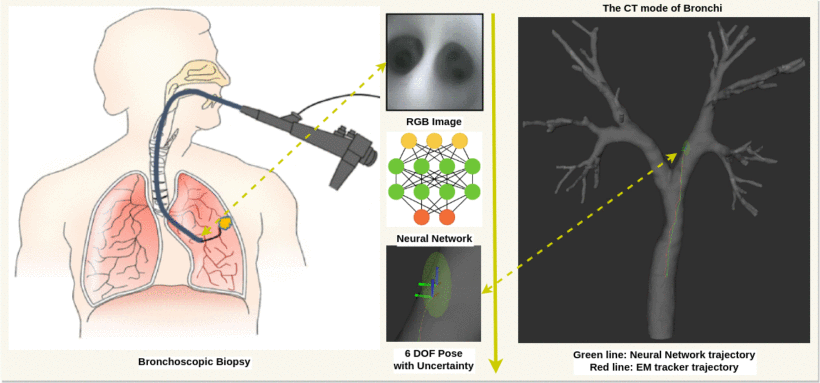
Dandan Zhang, Jindong Liu, Anzhu Gao, Guang-Zhong Yang. “An Ergonomic Shared Workspace Analysis Framework for the Optimal Placement of a Compact Master Control Console.” International Conference on Robotics and Automation (ICRA), 2020.
Master-Slave control is commonly used for RobotAssisted Minimally Invasive Surgery (RAMIS). The configuration, as well as the placement of the master manipulators, can influence the remote control performance. An ergonomic shared workspace analysis framework is proposed in this paper. Combined with the workspace of the master manipulators and the human arms, the human-robot interaction workspace can be generated. The optimal master robot placement can be determined based on three criteria: 1) interaction workspace volume, 2) interaction workspace quality, and 3) intuitiveness for slave robot control. Experimental verification of the platform is conducted on a da Vinci Research Kit (dVRK). An in-house compact master manipulator (Hamlyn CRM) is used as the master robot and the da Vinci robot is used as the slave robot. Comparisons are made between with and without using design optimization to validate the effectiveness of ergonomic shared workspace analysis. Results indicate that the proposed ergonomic shared workspace analysis can improve the performance of teleoperation in terms of task completion time and the number of clutching required during operation.
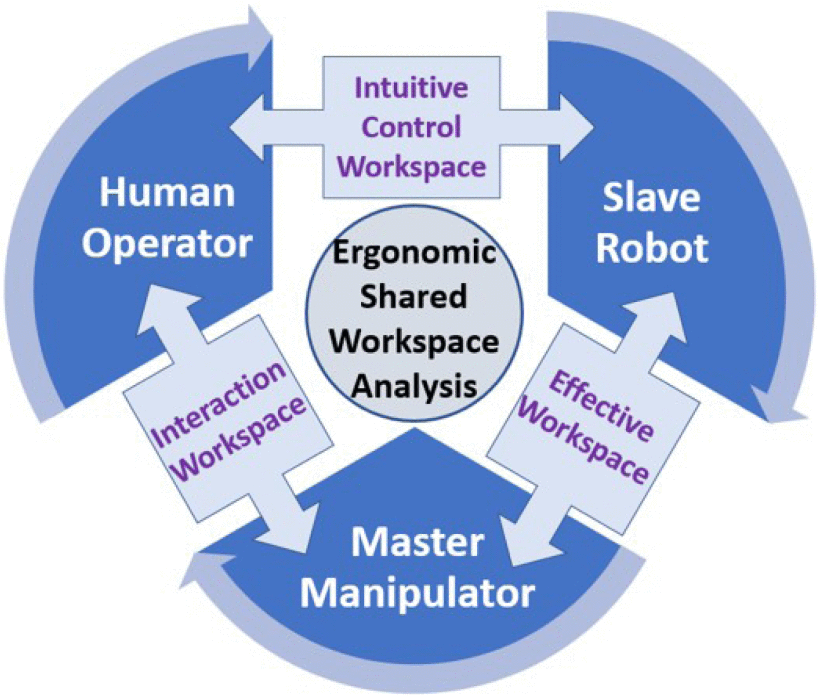
Hanxiao Zhang, Mali Shen, Pallav L Shah, Guang-Zhong Yang. “Pathological Airway Segmentation with Cascaded Neural Networks for Bronchoscopic Navigation.” International Conference on Robotics and Automation (ICRA), 2020.
Robotic bronchoscopic intervention requires detailed 3D airway maps for both localisation and enhanced visualisation, especially at peripheral airways. Patient-specific airway maps can be generated from preoperative chest CT scans. Due to pathological abnormalities and anatomical variations, automatically delineating the airway tree with distal branches is a challenging task. In the paper, we propose a cascaded 2D+3D model that has been tailored for airway segmentation from pathological CT scans. A novel 2D neural network is developed to generate the initial predictions where the peripheral airways are refined by a 3D adversarial training model. A sampling strategy based on a sequence of morphological operations is employed for the concatenation of the 2D and 3D models. The method has been validated on 20 pathological CT scans with results demonstrating improved segmentation accuracy and consistency, especially in peripheral airways.

Hongle Xie, Weidong Chen, Jingchuan Wang, Hesheng Wang. “Hierarchical Quadtree Feature Optical Flow Tracking Based Sparse Pose-Graph Visual-Inertial SLAM.” International Conference on Robotics and Automation (ICRA), 2020.
Accurate, robust and real-time localization under constrained-resources is a critical problem to be solved. In this paper, we present a new sparse pose-graph visual-inertial SLAM (SPVIS). Unlike the existing methods that are costly to deal with a large number of redundant features and 3D map points, which are inefficient for improving positioning accuracy, we focus on the concise visual cues for high-precision pose estimating. We propose a novel hierarchical quadtree based optical flow tracking algorithm, it achieves high accuracy and robustness within very few concise features, which is only about one fifth features of the state-of-the-art visual-inertial SLAM algorithms. Benefiting from the efficient optical flow tracking, our sparse pose-graph optimization time cost achieves bounded complexity. By selecting and optimizing the informative features in sliding window and local VIO, the computational complexity is bounded, it achieves low time cost in long-term operation. We compare with the state-of-the-art VIO/VI-SLAM systems on the challenging public datasets by the embedded platform without GPUs, the results effectively verify that the proposed method has better real-time performance and localization accuracy.

Rejin John Varghese, Benny P L Lo, Guang-Zhong Yang. “Design and Prototyping of a Bio-inspired Kinematic Sensing Suit for the Shoulder Joint: Precursor to a Multi-DoF Shoulder Exosuit.” International Conference on Robotics and Automation (ICRA), 2020.
Soft wearable robots represent a promising new design paradigm for rehabilitation and active assistance applications. Their compliant nature makes them ideal for complex joints, but intuitive control of these robots require robust and compliant sensing mechanisms. In this work, we introduce the sensing framework for a multiple degrees-of-freedom shoulder exosuit capable of sensing the kinematics of the joint. The proposed sensing system is inspired by the body’s embodied kinematic sensing, and the organisation of muscles and muscle synergies responsible for shoulder movements. A motioncapture-based evaluation study of the developed framework confirmed conformance with the behaviour of the muscles that inspired its routing. This validation of the tendon-routing hypothesis allows for it to be extended to the actuation framework of the exosuit in the future. The sensor-to-joint-space mapping is based on multivariate multiple regression and derived using an Artificial Neural Network. Evaluation of the derived mapping achieved root mean square error of ≈ 5.43◦ and ≈ 3.65◦ for the azimuth and elevation joint angles measured over 29,500 frames (4+ minutes) of motion-capture data.
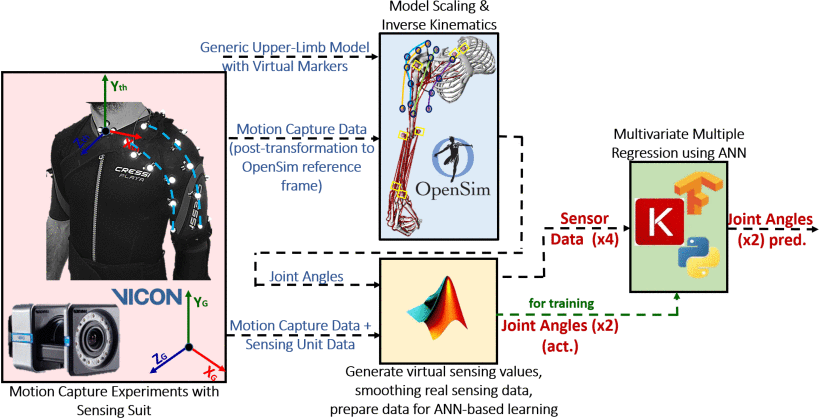
Wenqiang Chi, Giulio Dagnino, Trevor M. Y. Kwok, Anh Nguyen, Dennis Kundrat, Mohamed E. M. K. Abdelaziz, Celia Riga, Colin Bicknell, Guang-Zhong Yang. “Collaborative Robot-Assisted Endovascular Catheterization with Generative Adversarial Imitation Learning.” International Conference on Robotics and Automation (ICRA), 2020.
Master-slave systems for endovascular catheterization have brought major clinical benefits including reduced radiation doses to the operators, improved precision and stability of the instruments, as well as reduced procedural duration. Emerging deep reinforcement learning (RL) technologies could potentially automate more complex endovascular tasks with enhanced success rates, more consistent motion and reduced fatigue and cognitive workload of the operators. However, the complexity of the pulsatile flows within the vasculature and non-linear behavior of the instruments hinder the use of model-based approaches for RL. This paper describes modelfree generative adversarial imitation learning to automate a standard arterial catherization task. The automation policies have been trained in a pre-clinical setting. Detailed validation results show high success rates after skill transfer to a different vascular anatomical model. The quality of the catheter motions also shows less mean and maximum contact forces compared to manual-based approaches.

Wuzhou Hong, Andreas Schmitz, Weibang Bai, Pierre Berthet-Rayne, Le Xie, Guang-Zhong Yang. “Design and Compensation Control of a Flexible Instrument for Endoscopic Surgery.” International Conference on Robotics and Automation (ICRA), 2020.
Snake-like robots for endoscopic surgery make it possible to reach deep-seated lesions. With the use of small flexible tendon-driven instruments, it is possible to perform bimanual micro-surgical tasks that are challenging for standard endoscopic surgeries. Existing devices, however, lack articulated wrists and rolling motion of the end-effector. This paper presents a new instrument design with a distal-roll gripper for snake-like robots. The developed 5 DoFs miniaturized instruments with a diameter of 3 mm enable the deployment into narrow endoluminal channels. Issues related to actuation coupling, tendon slack, and backlash are addressed. Experimental results show that the distal-roll gripper can rotate 106◦ , and the actuated joints can achieve good repeatability and accuracy with the proposed compensation control scheme.

Xiao-Yun Zhou, Jian-Qing Zheng, Peichao Li, Guang-Zhong Yang. “ACNN: a Full Resolution DCNN for Medical Image Segmentation.” International Conference on Robotics and Automation (ICRA), 2020.
Deep Convolutional Neural Networks (DCNNs) are used extensively in medical image segmentation and hence 3D navigation for robot-assisted Minimally Invasive Surgeries (MISs). However, current DCNNs usually use down sampling layers for increasing the receptive field and gaining abstract semantic information. These down sampling layers decrease the spatial dimension of feature maps, which can be detrimental to image segmentation. Atrous convolution is an alternative for the down sampling layer. It increases the receptive field whilst maintains the spatial dimension of feature maps. In this paper, a method for effective atrous rate setting is proposed to achieve the largest and fully-covered receptive field with a minimum number of atrous convolutional layers. Furthermore, a new and full resolution DCNN - Atrous Convolutional Neural Network (ACNN), which incorporates cascaded atrous II-blocks, residual learning and Instance Normalization (IN) is proposed. Application results of the proposed ACNN to Magnetic Resonance Imaging (MRI) and Computed Tomography (CT) image segmentation demonstrate that the proposed ACNN can achieve higher segmentation Intersection over Unions (IoUs) than UNet and Deeplabv3+, but with reduced trainable parameters.

Ya-Yen Tsai, Bo Xiao, Edward Johns, Guang-Zhong Yang. “Constrained-Space Optimization and Reinforcement Learning for Complex Tasks.” International Conference on Robotics and Automation (ICRA), 2020.
Learning from Demonstration is increasingly used for transferring operator manipulation skills to robots. In practice, it is important to cater for limited data and imperfect human demonstrations, as well as underlying safety constraints. This paper presents a constrained-space optimization and reinforcement learning scheme for managing complex tasks. Through interactions within the constrained space, the reinforcement learning agent is trained to optimize the manipulation skills according to a defined reward function. After learning, the optimal policy is derived from the well-trained reinforcement learning agent, which is then implemented to guide the robot to conduct tasks that are similar to the experts’ demonstrations. The effectiveness of the proposed method is verified with a robotic suturing task, demonstrating that the learned policy outperformed the experts’ demonstrations in terms of the smoothness of the joint motion and end-effector trajectories, as well as the overall task completion time.
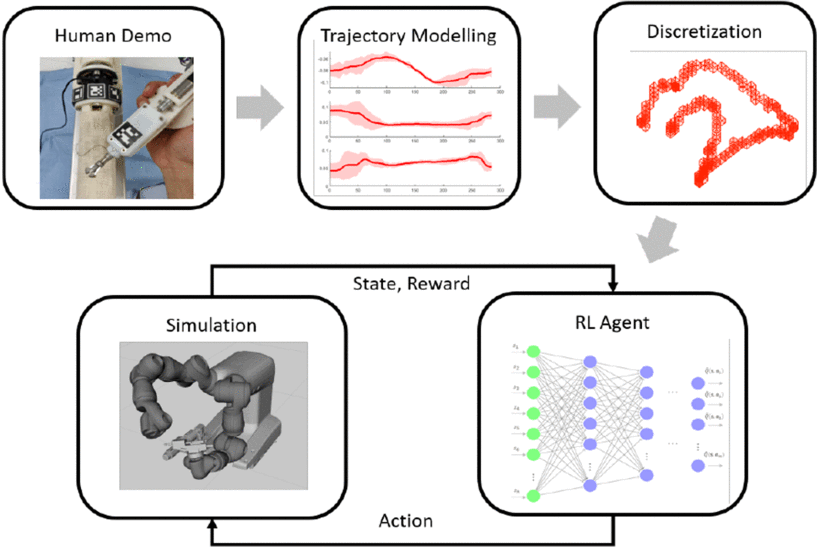
Zicong Wu, Anzhu Gao, Ning Liu, Zhu Jin, Guang-Zhong Yang. “FBG-Based Triaxial Force Sensor Integrated with an Eccentrically Configured Imaging Probe for Endoluminal Optical Biopsy.” International Conference on Robotics and Automation (ICRA), 2020.
Accurate force sensing is important for endoluminal intervention in terms of both safety and lesion targeting. This paper develops an FBG-based force sensor for robotic bronchoscopy by configuring three FBG sensors at the lateral side of a conical substrate. It allows a large and eccentric inner lumen for the interventional instrument, enabling a flexible imaging probe inside to perform optical biopsy. The force sensor is embodied with a laser-profiled continuum robot and thermo drift is fully compensated by three temperature sensors integrated on the circumference surface of the sensor substrate. Different decoupling approaches are investigated, and nonlinear decoupling is adopted based on the cross-validation SVM and a Gaussian kernel function, achieving an accuracy of 10.58 mN, 14.57 mN and 26.32 mN along X, Y and Z axis, respectively. The tissue test is also investigated to further demonstrate the feasibility of the developed triaxial force sensor.
